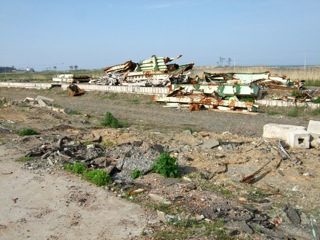Soma, Fukushima Prefecture
- At July 27, 2016
- By anneblog
- In Annes Letters
 0
0
Dear Family and Friends,
Fukushima has a terrible reputation now because of the nuclear problems. No one wants to go there or to buy anything from there, even though many of the farms are in the west of the prefecture, far from the contaminated area. But this group chose Fukushima, the Soma area, for several reasons. One was because a member was born in Soma. Also it was an easy and pleasant day trip from Sendai. But mostly we wanted to lend our support to the people of that devastated prefecture. We hoped that somehow our positive attitude and presence would at least encourage the people we met. And of course, the few things we bought would help the struggling economy, even if only a little.
In Sendai these days we see cars from all over the country. Some people have come for work, others for school. Many are still here for relief efforts. But in Fukushima every car we saw, besides our own, was from Fukushima itself. People are avoiding the entire prefecture, even though most places in it have no nuclear fallout.
After a relatively easy hike with gorgeous forest and mountain views, we decided to drive back to Sendai along the coast to see how things were progressing there. Even though the Great East Japan Earthquake and Tsunami occurred over a year ago, to this day being in damaged areas is still a deeply arresting experience.
In coastal Soma an enormous area of homes had been completely wrecked by the tsunami. Since then the clean up job has been impressive. Essentially very little remains. The area is mostly wide open space with nothing but a lone tree or the shell of one house here, another there. Even now, many months later, the silence is deep and penetrating.

We went to where the train station had been. There we could see where the tracks had once stood, with remains of the platforms, crumbled train cars, and shattered toilets. It was haunting. Somehow the life once there could still be felt and seemed to echo in the still soggy, salty earth and ocean breeze.

The whole scene reminded me of two poems. The first by Tu Fu, the second by Basho.
“The whole country devastated,
only mountains and rivers remain.”
“Summer grasses:
all that remains of great soldiers’
imperial dreams”

A little further down we came upon an old woman with a floppy hat and a hoe. We stopped to talk with her and she told us her story. She was standing where her large traditional farmhouse had been. There were huge rocks that had been part of her Japanese garden. And to one side gracious violet poppies were bobbing in the wind. “I used to plant these every year,” she told us, “but of course, I couldn’t last year. But somehow the seeds survived the tsunami and now there is this beautiful patch of flowers. There’s nothing else left. But the flowers are so kind, so I come here whenever I can, just to look at them.”

Then she told us how she and the other family members had headed for high ground as soon as the earthquake hit. “We knew we had very little time, especially because our house was so close to the sea. So, we raced away without taking anything. Now all we have is our lives, but the government is allowing us to stay in a temporary home for a while. After that we have no idea. We are old and have no jobs. We really don’t know what we are going to do.”
The problems up the entire coast from Fukushima to the tip of Iwate are huge. What to do with the devastated land? Most of it is privately owned, so the government cannot step in and force everyone to leave for good. It would like to, though, because then administratively things would be a lot easier. The entire coastal area could be turned into parks, with fish factories and warehouses beyond them, and residential areas the furthest from the life-giving, but threatening sea. But many people along the coast have died. And others do not want to give up their ancestral property. Japan works by consensus. In theory that means everyone is given a say and everyone’s wishes and ideas are taken into account. So negotiations are painfully slow.
In the meantime, people wait. They wait even as they look for work. They wait even as they return to their now empty land to feel a sense of roots and continuity. They wait as the prefecture and national governments go back and forth as to policy. They wait even as Tokyo Electric Company begrudgingly pays compensation money to people in Fukushima’s nuclear area. Everything seems to be on hold.
Is there hope? It is hard to say. Alcoholism, drug abuse, and suicides continue to rise. Many, many feel a deep, dark sense of despair. Yet, too, there is a strong sense of resignation. But a sense of the future? No, not now. Not yet . . .
Or is there? As we drove by a wide area now empty of homes, we saw a small, newly built Shinto shrine. It was sitting in the center of a family’s lot, by itself, clear and strong. Although it had been placed there to honor the deceased and to protect the spot from further harm, its presence seemed to exude a sense of gentle, but pervasive defiance. It stood there, “strong in the rain, strong in the wind” (1), simply refusing to accept defeat. It was solitary, but surely not alone. In fact, it seemed decidedly pregnant with the hope of better and happier times to come.

(1) From Miyazawa Kenji’s poem “Strong in the Rain”



